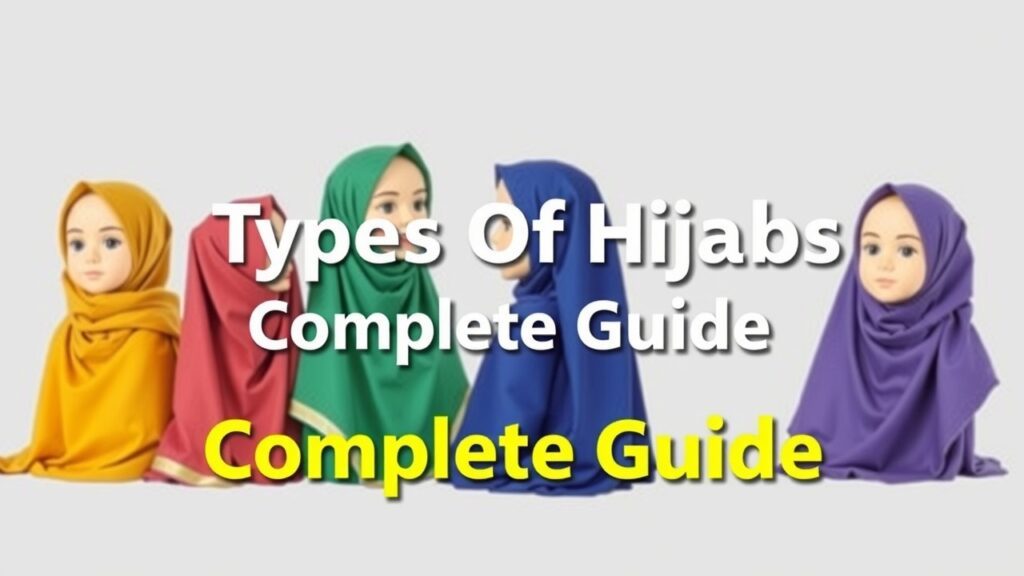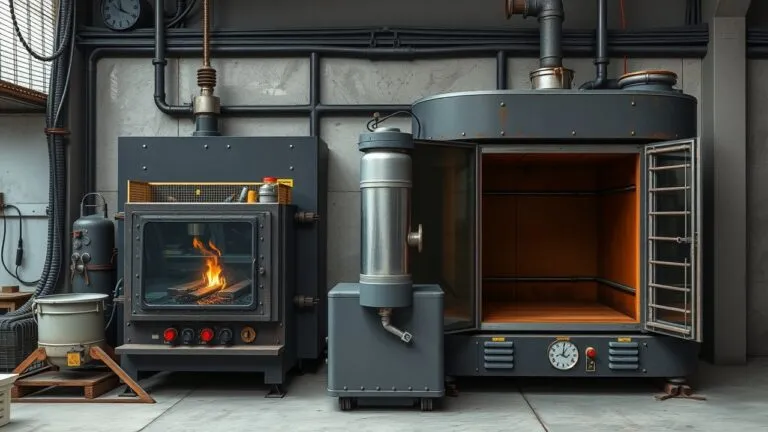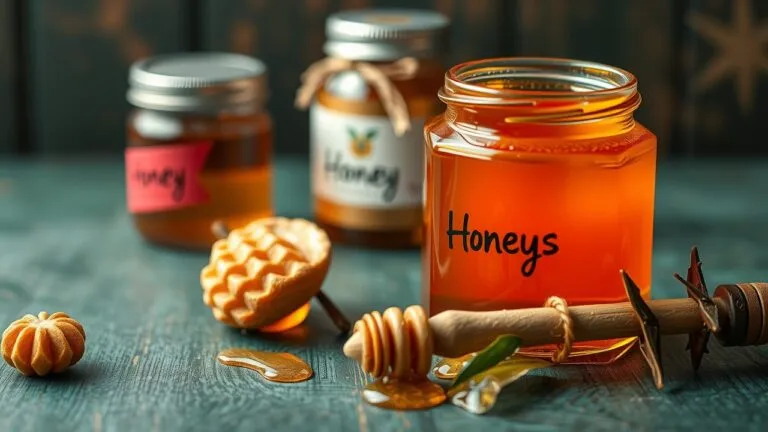Discover the many types of hijab, from simple scarves to elaborate styles like the khimar and shayla. This guide covers various fabrics, helping you choose the perfect hijab for any occasion.
What is a Hijab?

A hijab is a type of headscarf that many Muslim women wear. It is part of their cultural and religious identity. The word “hijab” means “to cover” in Arabic. This scarf represents modesty and privacy, important values in Islam.
There are many styles of hijabs. Some popular ones are the Shayla, which is long and wraps around the shoulders, and the Khimar, which covers the chest. There’s also the Al-Amira, a fitted cap with a separate scarf. Each style shows how modest fashion can be personal and expressive.
For many women, wearing a hijab is about faith. It shows their commitment to Islamic teachings on dressing modestly. But not everyone wears it the same way; some might put it on every day, while others might only wear it for special events.
Why Are There Different Types of Hijabs?
There are different types of hijabs because cultures vary widely and people have different tastes. This variety allows women to show who they are while following modesty guidelines.
Here’s a list of some common types of hijabs:
- Hijab: A broad term for any head covering.
- Shayla: A long rectangular scarf popular in places like the Gulf.
- Khimar: A cape-like garment that covers the shoulders.
- Chador: A full-body cloak usually seen in Iran.
- Niqab: Covers most of the face but leaves the eyes clear.
Choosing a hijab can depend on several things like comfort, weather, or personal style. Women who are new to wearing them often start with simpler styles. As they get used to it, they may try different ones that fit better with their lives and beliefs.
Understanding these types helps women pick what works best for them while staying true to their beliefs.
Hijab Fabrics: A Detailed Guide
Cotton Hijabs
Cotton hijabs are a favorite for many women. They’re breathable and lightweight, making them great for warm weather and everyday wear. You can easily toss them in the washing machine, which is super convenient. On the downside, they might not look as fancy compared to other fabrics.
Cotton hijabs come in many patterns. Some are plain while others have fun prints, so you can show off your style while being modest.
Silk Hijabs
Silk hijabs feel luxurious and look shiny. They’re perfect for special events like weddings or parties. The way silk drapes can really enhance your outfit. But remember, silk needs gentle care. It’s best to wash it by hand or take it to the dry cleaner.
Polyester Hijabs
Polyester hijabs are budget-friendly and last a long time. They resist wrinkles, so you won’t spend much time ironing them. However, they may not let air flow as well as cotton or linen, which could be a bit uncomfortable when it’s hot outside.
Linen Hijabs
Linen hijabs have a natural texture that lets air flow through, making them a good choice for summer days. They help keep you cool but tend to wrinkle easily, so they might need some extra attention.
Chiffon Hijabs
Chiffon hijabs are light and flowy. This fabric is perfect for layering and creating pretty looks. They add style but be careful; chiffon can be fragile and needs some gentle handling to avoid tears.
Velvet Hijabs
Velvet hijabs are warm and cozy. They’re great for cold weather or special occasions where you want to look stylish. Just keep in mind that velvet can be heavy, so it’s good to pick the right occasion to wear them.
Other Popular Fabrics
There are more fabrics often used in hijabi fashion:
- Jersey: This stretchy material is super comfy and allows easy movement.
- Georgette: Lightweight with a slightly textured feel; it’s very versatile.
- Rayon: Soft against the skin, making it pleasant to wear.
- Modal: Breathable and smooth; it feels nice too.
These fabrics cater to different styles and comfort preferences in modest fashion.
Fabric Care Guide
Taking care of your hijab fabrics helps them last longer! Here’s how to keep your favorite ones looking great:
| Fabric Type | Washing Instructions | Drying Instructions | Ironing Instructions |
|---|---|---|---|
| Cotton | Machine wash on cold | Tumble dry on low | Use medium heat |
| Silk | Hand wash only | Lay flat or hang dry | Low heat |
| Polyester | Machine wash on warm | Tumble dry on low | No direct heat |
| Linen | Hand wash preferred | Hang dry | Steam iron if needed |
| Chiffon | Hand wash gently | Air dry | Use low setting |
| Velvet | Spot clean if needed | Hang up immediately | Avoid direct contact |
Following these tips will help keep your hijabs beautiful and ready for any occasion!
Popular Hijab Styles and Draping Techniques
Plain Hijab Styles
Plain hijabs are a must-have in any wardrobe. They are simple and can match almost any outfit. Made from lightweight fabrics, they are great for daily wear. A classic wrap is the most common style. It’s easy to adjust and suits different face shapes. You can find simple hijabs in many colors, so it’s easy to mix and match with your clothes. Neutral shades or soft pastels work well for a timeless look.
Key Features of Plain Hijab Styles:
- Everyday Use: Perfect for daily activities because they’re so simple.
- Lightweight Fabrics: Materials like cotton or chiffon keep you comfy all day.
- Classic Wrap Technique: Easy to learn, even for beginners.
Instant Hijabs
Instant hijabs are super popular for those who want style without hassle. These beginner-friendly options come pre-styled. You can put them on quickly, which is awesome for busy mornings or casual outings. They’re available in lots of designs and colors, making it easy to stay fashionable while being modest.
Benefits of Instant Hijabs:
- Quick Wear: No tricky wrapping needed.
- Casual Style Options: Great for relaxed days or social events.
- Variety of Designs: From fun patterns to solid colors, there’s something for everyone.
Turban Styles
Turban styles give a modern spin on traditional head coverings. This stylish option features unique draping that wraps around your head nicely. You can wear stylish turbans casually or dress them up for events. Learning how to wear a turban is simple, so even if you’re new to it, you’ll get the hang of it fast.
Characteristics of Turban Styles:
- Fashionable Look: Adds a fun touch while keeping things modest.
- Versatile Usage: Works well from day to night events.
Shayla Styles
Shayla styling uses long rectangular scarves that let you play around with different draping techniques. This style is classy and flexible; you can wrap it in many ways based on what you like or what the occasion calls for. Shayla styles offer full coverage and look stylish at the same time.
Draping Techniques Include:
- Wrap it around once with loose ends hanging down.
- tie it at the back after securing over your shoulders.
Khimar Styles
Khimar styles give full coverage while still looking chic and comfortable. These capes cover not just your hair but also your shoulders and chest area, giving you extra modesty without losing style underneath.
Types of Khimar:
- Long khimars reach below your waist for maximum coverage.
- Shorter ones sit just above your hips, allowing more freedom but still looking modest.
Niqab
The niqab covers the face except for the eyes and holds cultural significance in many Muslim communities. Wearing a niqab varies greatly depending on culture and personal beliefs about modesty.
Understanding types of niqab helps appreciate diversity:
- Full-face covering leaving only the eye area visible (often worn with an abaya).
- Half-niqabs cover only part of the face while leaving the upper half exposed (more common in warmer weather).
Each type reflects individual beliefs along with local customs, showcasing a rich variety worldwide!
Choosing the Right Hijab for You
Hijab Styles for Different Face Shapes
When you pick a hijab, it’s good to think about your face shape. The right style can make you look even better and feel more confident. Here are some common face shapes and the best hijab styles for each:
- Oval Face: You can wear almost any hijab style! A turban or wrap that frames your face is a great choice.
- Round Face: Go for styles that add height, like high bun wraps or layered drapes. Try to avoid round styles; instead, look for ones with angles.
- Square Face: Softening sharp angles is important. Flowing fabrics like shawls work well to create a rounded look.
- Heart-Shaped Face: A side-draped hijab helps balance a wider forehead with a narrower chin. Lightweight materials help it flow nicely.
Understanding these options can help you choose stylish hijabs that fit your features while keeping you comfy and chic.
Hijabs for Different Occasions
The event often guides what type of hijab to wear:
- Everyday Hijabs: For daily wear, breathable fabrics like cotton or jersey keep you comfy all day long.
- Formal Hijabs: Silk or chiffon look classy at formal events because they hold intricate styles well.
- Casual Hijabs: Lightweight materials like rayon are perfect when you’re just hanging out with friends.
- Hijabs for Weddings/Parties: Look for embellished options with sequins or lace to make your outfit pop at special events without overpowering it.
Choosing the right types of hijabs based on the occasion helps you feel stylish and confident no matter where you go.
Hijab Styles Based on Climate
| Season | Recommended Fabrics | Style Suggestions |
|---|---|---|
| Summer | Breathable cotton, linen | Loose wraps or light shawls |
| Winter | Wool blends, heavier knits | Layered looks with scarves |
| Rainy season | Waterproof materials | Quick-dry wraps |
In hot weather, light fabrics keep you cool while covering up. In winter, thicker materials provide warmth without losing style. Always think about local weather when picking different types of hijabs so they meet your needs and preferences effectively.
Hijab and Personal Style
Your personal style shows who you are, so it’s key to blend it with how you wear a hijab.
Experimenting with colors lets you express yourself—bold colors catch attention, while pastels are soft and subtle. Mixing patterns can add fun; just balance busy prints with solid colors to keep things from clashing.
Accessorizing is fun too! Brooches or pins can add charm while still being modest in line with many cultures around modest fashion today among Muslim women worldwide looking for stylish yet respectful ways to express their identity through clothing choices.
Hijab Accessories and Styling Tips
Hijab Accessories
When you want to upgrade your hijab look, using hijab accessories is a great idea. These items can help you be stylish and practical at the same time.
Hijab Pins: These are super important for keeping your hijab in place. You can find them in many styles. Some are even decorative, adding a nice touch to your outfit.
Hijab Magnets: These magnets are a cool option if you don’t want to use pins. They hold your scarf securely without ruining the fabric. Plus, they’re easy to use and work great for quick styling.
Under Scarves: These go under your main hijab and help keep everything in order. They also give you extra coverage around your neck. Under scarves come in soft materials like cotton or silk, which makes them comfy.
Stylish hijabs often mix these accessories into their looks, making them both useful and trendy.
Hijab Styling Tutorials
Do you wanna learn how to style a hijab? It’s fun! There are lots of tutorials online that can teach you different ways to wear it.
For beginners, there are many step-by-step hijab tutorials that show how to create popular styles, like the Turkish wrap or the classic drape. Most tutorials have clear pictures and easy-to-follow steps to help you get the look right.
These guides make it simple for anyone who wants to wear their headscarf with confidence and style.
Accessorizing Your Hijab
Accessorizing your hijab lets you show off your style while staying modest. You can add things like bold earrings or layered necklaces that match your outfit’s colors and patterns.
Fashionable hijabs often have unique prints or details that help you stand out while sticking to modest fashion rules. For instance, try pairing a solid-colored outfit with a patterned scarf or the other way around. This mix adds interest without making things too busy.
Mixing seasonal trends into your accessories can also keep your looks fresh throughout the year!
Troubleshooting Common Hijab Issues
Wearing a hijab might come with some challenges, but most problems have simple fixes! One common issue is slippage; this happens when your scarf shifts during wear.
To tackle slippage issues with the hijab, choose good under scarves or pick fabrics that grip well, like jersey material. These fabrics not only stay put better but also feel comfortable for all-day wear.
Using pins or magnets to secure the scarf will also help keep it in place so you can feel confident wherever you go!
Ethical and Sustainable Hijab Choices
Ethical Sourcing of Hijabs
When you choose a hijab, think about where it comes from. Ethical hijabs come from brands that care about fair work conditions and eco-friendly production. Many modest fashion brands now offer sustainable hijab options. These choices help you support companies that treat their workers well and protect the environment.
Sustainable Fabrics for Hijabs
Sustainable fabrics are key to making eco-friendly hijabs. Here are some materials to look for:
- Organic Cotton: Grown without harmful chemicals, it’s soft and breathable.
- Bamboo: This fabric is super soft and breaks down naturally.
- Recycled Materials: These help cut down on waste by using existing textiles.
These eco-friendly options not only help the planet but also give you comfort and style in your modest fashion wardrobe.
Supporting Local Artisans
Buying from local artisans is a great way to make ethical choices with your hijab purchase. Handmade hijabs show off traditional skills passed down through generations. When you buy from local businesses or artisans, you’re helping to keep these crafts alive and boosting the local economy.
The Importance of Transparency in Fashion
It’s becoming really important to know where your clothes come from. Brands that practice transparency share info about how they source materials and treat their workers. This helps build trust with shoppers who care about ethical fashion practices.
Tips for Choosing Eco-Friendly Hijabs
Choosing sustainable hijabs can be simple if you follow these tips:
- Look for certifications: Find labels that show organic or fair-trade standards.
- Research brands: Check how committed a company is to sustainability.
- Prioritize quality: Invest in durable pieces instead of fast-fashion items.
- Consider versatility: Pick styles that can be worn in different ways or with various outfits.
By keeping these ideas in mind when selecting your next hijab, you’ll make choices that are good for both your style and the world around you.
Frequently Asked Questions about Hijabs
What are the best hijab fabrics for summer?
For summer, choose breathable fabrics like cotton, linen, and jersey. These materials keep you cool and comfortable. They also offer various styles, making it easy to find your perfect fit.
How do I care for my hijab?
Caring for your hijab depends on the fabric type. Most cotton hijabs can be machine-washed, while silk needs hand washing. Always check the care label for specific instructions to maintain quality.
Can I wear a hijab while exercising?
Yes! Look for sporty hijabs made from stretchy and breathable materials. They provide comfort and flexibility during workouts while maintaining modesty.
How do I choose a hijab color that suits me?
Consider your skin tone when selecting a hijab color. Warm tones look great with earthy colors, while cool tones pair well with pastels or jewel tones. Experiment to find shades that enhance your look.
What are instant hijabs?
Instant hijabs are pre-styled headscarves designed for easy wear. They come in various styles and colors, making them perfect for busy days or quick outings.
Additional Tips for Choosing the Right Hijab
- Understand Your Style: Determine if you prefer modern or traditional looks.
- Mix Patterns Wisely: Pair patterned hijabs with solid outfits to create balance.
- Explore Different Styles: Try various wraps, drapes, or turban styles to discover what feels best.
- Invest in Quality: High-quality fabrics last longer and look better over time.
- Consider Occasion: Choose different types of hijabs based on whether it’s for daily wear or special events.
Stylish Hijab Options
- Turban Styles: Modern look with stylish draping.
- Khimar Styles: Full coverage with elegant designs.
- Shayla Styles: Versatile rectangular scarves allowing creativity.
- Niqab Styles: Cover face with options varying by culture.
These options cater to diverse preferences while ensuring modesty remains a priority. Whether you’re looking for fashionable pieces or comfortable options, there’s a hijab style for every occasion.
Related Topics
- Types of Hijab Fabrics
- Types of Hijab Styles
- Types of Hijab Accessories
- Types of Niqabs
- Types of Khimar
- Types of Shayla
- Types of Sustainable Hijab Fabrics
- Types of Instant Hijabs
- Types of Plain Hijab Styles
- Types of Turban Styles



Types of Hijab: A Complete Guide to Styles, Fabrics, and Occasions